Talent Management Strategies: A Case Study on Sainsbury's Business
VerifiedAdded on 2023/01/03
|19
|4493
|99
Report
AI Summary
This report examines talent management strategies at Sainsbury's, focusing on attracting and retaining talent. It includes a project management plan outlining aims, objectives, and deliverables, as well as a work breakdown structure and Gantt chart for project timelines. The research employs primary and secondary data collection methods, followed by data analysis and presentation using appropriate tools. The report presents recommendations based on the findings and reflects on the project's value, aiming to provide actionable insights for improving employee retention within the organization. The study also reviews literature on talent management, analyzing strategies, challenges, and methodologies used in the case study, ultimately providing a comprehensive analysis of talent retention in the context of Sainsbury's.
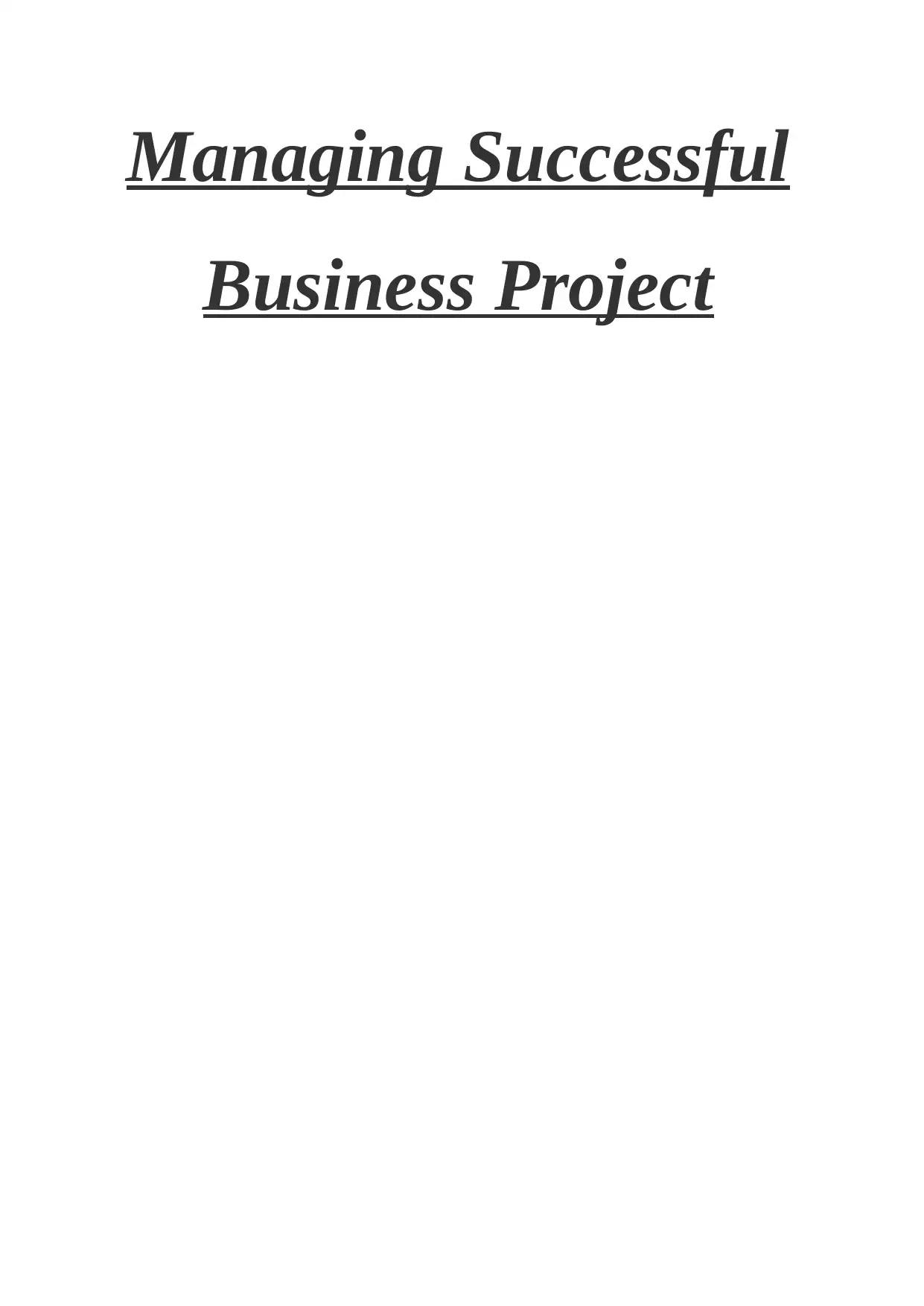
Managing Successful
Business Project
Business Project
Paraphrase This Document
Need a fresh take? Get an instant paraphrase of this document with our AI Paraphraser
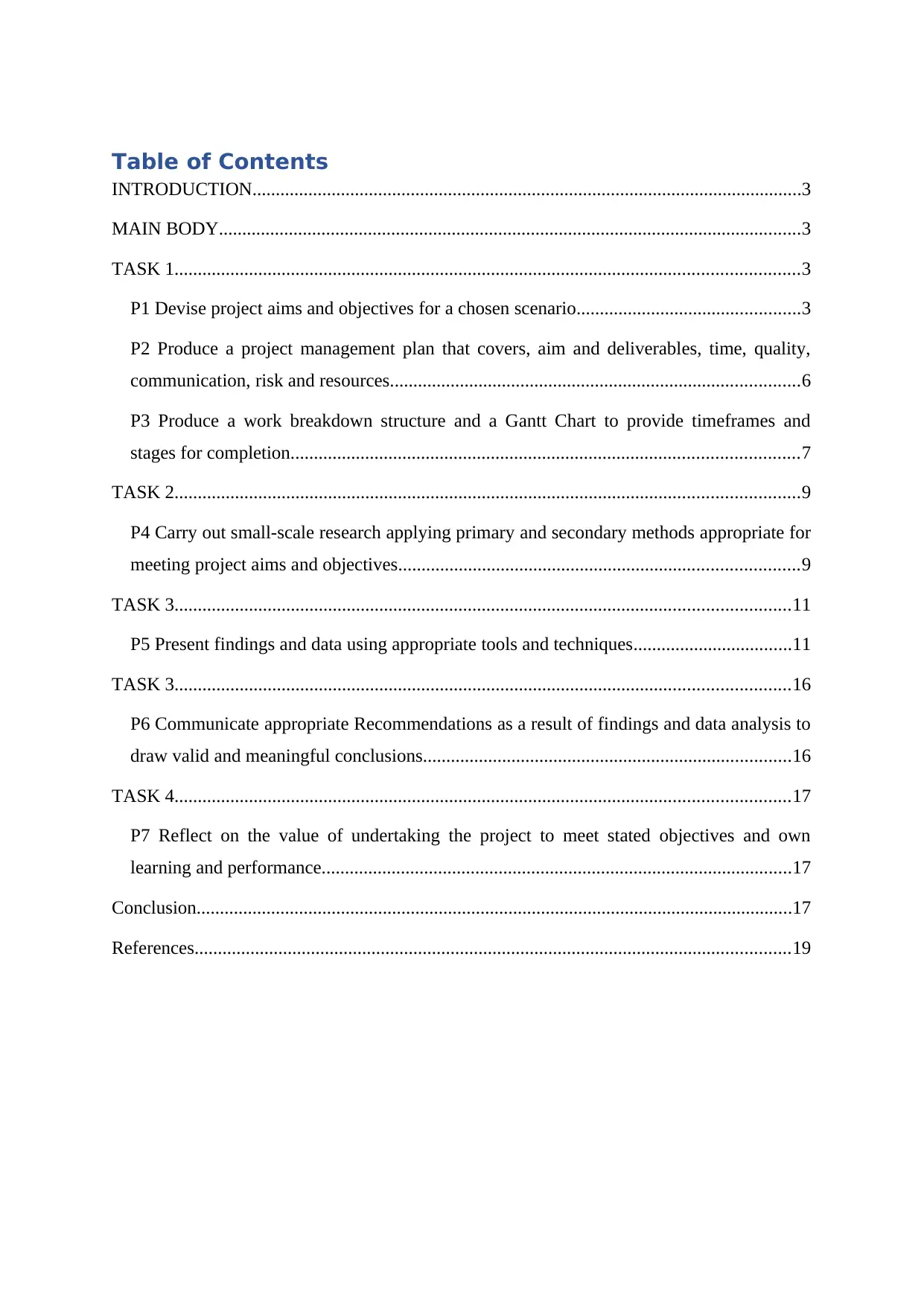
Table of Contents
INTRODUCTION......................................................................................................................3
MAIN BODY.............................................................................................................................3
TASK 1......................................................................................................................................3
P1 Devise project aims and objectives for a chosen scenario................................................3
P2 Produce a project management plan that covers, aim and deliverables, time, quality,
communication, risk and resources........................................................................................6
P3 Produce a work breakdown structure and a Gantt Chart to provide timeframes and
stages for completion.............................................................................................................7
TASK 2......................................................................................................................................9
P4 Carry out small-scale research applying primary and secondary methods appropriate for
meeting project aims and objectives......................................................................................9
TASK 3....................................................................................................................................11
P5 Present findings and data using appropriate tools and techniques..................................11
TASK 3....................................................................................................................................16
P6 Communicate appropriate Recommendations as a result of findings and data analysis to
draw valid and meaningful conclusions...............................................................................16
TASK 4....................................................................................................................................17
P7 Reflect on the value of undertaking the project to meet stated objectives and own
learning and performance.....................................................................................................17
Conclusion................................................................................................................................17
References................................................................................................................................19
INTRODUCTION......................................................................................................................3
MAIN BODY.............................................................................................................................3
TASK 1......................................................................................................................................3
P1 Devise project aims and objectives for a chosen scenario................................................3
P2 Produce a project management plan that covers, aim and deliverables, time, quality,
communication, risk and resources........................................................................................6
P3 Produce a work breakdown structure and a Gantt Chart to provide timeframes and
stages for completion.............................................................................................................7
TASK 2......................................................................................................................................9
P4 Carry out small-scale research applying primary and secondary methods appropriate for
meeting project aims and objectives......................................................................................9
TASK 3....................................................................................................................................11
P5 Present findings and data using appropriate tools and techniques..................................11
TASK 3....................................................................................................................................16
P6 Communicate appropriate Recommendations as a result of findings and data analysis to
draw valid and meaningful conclusions...............................................................................16
TASK 4....................................................................................................................................17
P7 Reflect on the value of undertaking the project to meet stated objectives and own
learning and performance.....................................................................................................17
Conclusion................................................................................................................................17
References................................................................................................................................19
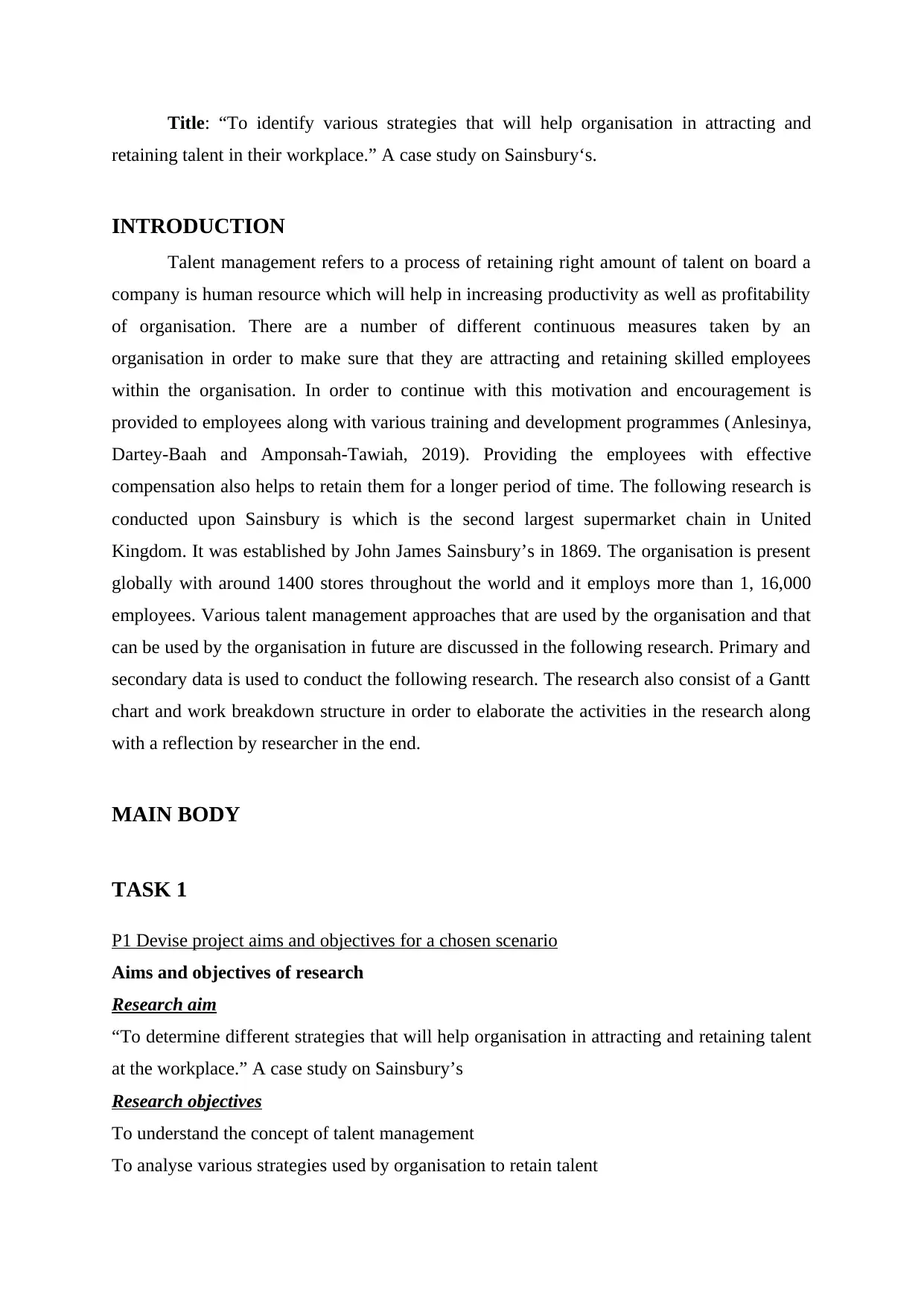
Title: “To identify various strategies that will help organisation in attracting and
retaining talent in their workplace.” A case study on Sainsbury‘s.
INTRODUCTION
Talent management refers to a process of retaining right amount of talent on board a
company is human resource which will help in increasing productivity as well as profitability
of organisation. There are a number of different continuous measures taken by an
organisation in order to make sure that they are attracting and retaining skilled employees
within the organisation. In order to continue with this motivation and encouragement is
provided to employees along with various training and development programmes (Anlesinya,
Dartey-Baah and Amponsah-Tawiah, 2019). Providing the employees with effective
compensation also helps to retain them for a longer period of time. The following research is
conducted upon Sainsbury is which is the second largest supermarket chain in United
Kingdom. It was established by John James Sainsbury’s in 1869. The organisation is present
globally with around 1400 stores throughout the world and it employs more than 1, 16,000
employees. Various talent management approaches that are used by the organisation and that
can be used by the organisation in future are discussed in the following research. Primary and
secondary data is used to conduct the following research. The research also consist of a Gantt
chart and work breakdown structure in order to elaborate the activities in the research along
with a reflection by researcher in the end.
MAIN BODY
TASK 1
P1 Devise project aims and objectives for a chosen scenario
Aims and objectives of research
Research aim
“To determine different strategies that will help organisation in attracting and retaining talent
at the workplace.” A case study on Sainsbury’s
Research objectives
To understand the concept of talent management
To analyse various strategies used by organisation to retain talent
retaining talent in their workplace.” A case study on Sainsbury‘s.
INTRODUCTION
Talent management refers to a process of retaining right amount of talent on board a
company is human resource which will help in increasing productivity as well as profitability
of organisation. There are a number of different continuous measures taken by an
organisation in order to make sure that they are attracting and retaining skilled employees
within the organisation. In order to continue with this motivation and encouragement is
provided to employees along with various training and development programmes (Anlesinya,
Dartey-Baah and Amponsah-Tawiah, 2019). Providing the employees with effective
compensation also helps to retain them for a longer period of time. The following research is
conducted upon Sainsbury is which is the second largest supermarket chain in United
Kingdom. It was established by John James Sainsbury’s in 1869. The organisation is present
globally with around 1400 stores throughout the world and it employs more than 1, 16,000
employees. Various talent management approaches that are used by the organisation and that
can be used by the organisation in future are discussed in the following research. Primary and
secondary data is used to conduct the following research. The research also consist of a Gantt
chart and work breakdown structure in order to elaborate the activities in the research along
with a reflection by researcher in the end.
MAIN BODY
TASK 1
P1 Devise project aims and objectives for a chosen scenario
Aims and objectives of research
Research aim
“To determine different strategies that will help organisation in attracting and retaining talent
at the workplace.” A case study on Sainsbury’s
Research objectives
To understand the concept of talent management
To analyse various strategies used by organisation to retain talent
⊘ This is a preview!⊘
Do you want full access?
Subscribe today to unlock all pages.

Trusted by 1+ million students worldwide
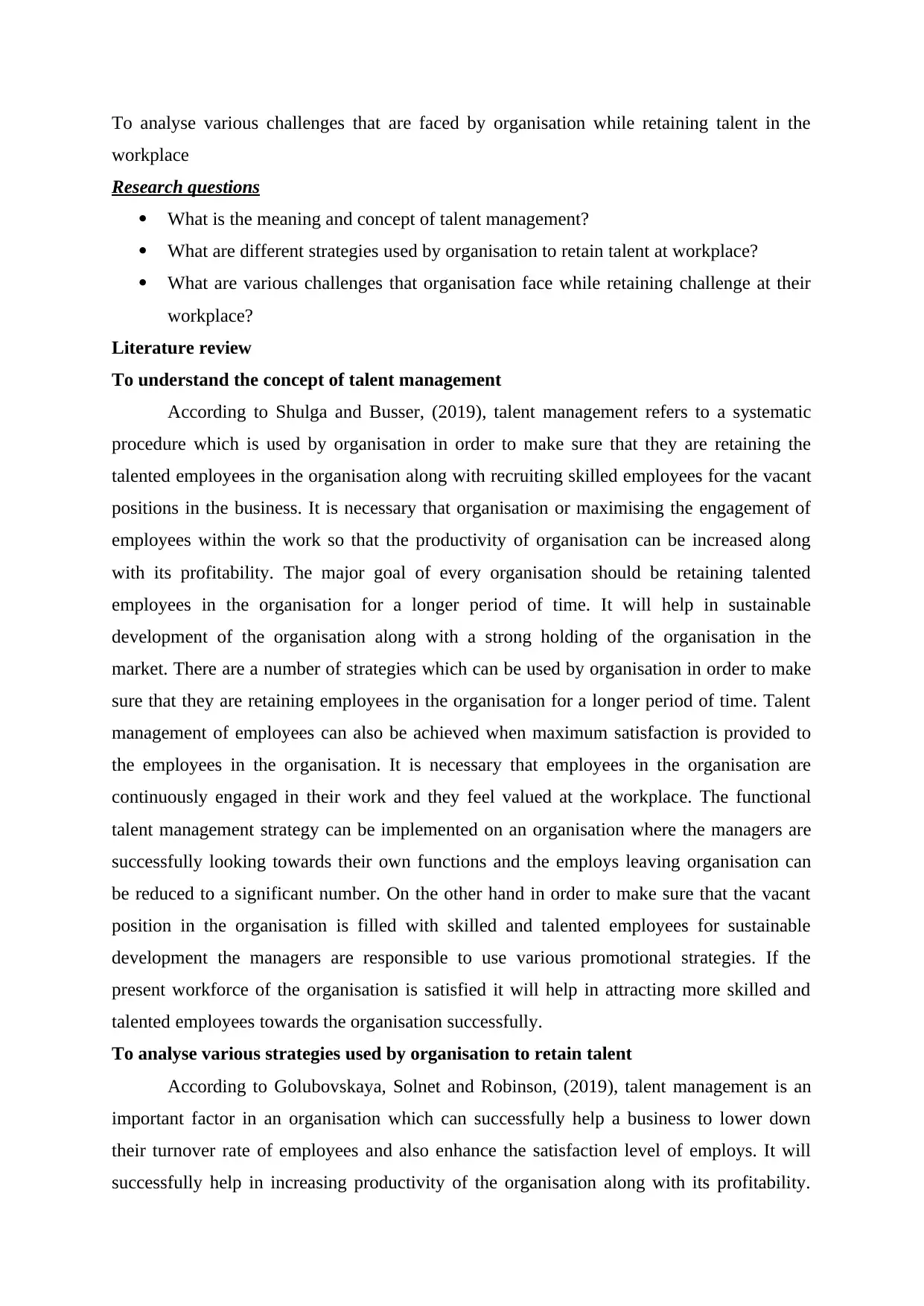
To analyse various challenges that are faced by organisation while retaining talent in the
workplace
Research questions
What is the meaning and concept of talent management?
What are different strategies used by organisation to retain talent at workplace?
What are various challenges that organisation face while retaining challenge at their
workplace?
Literature review
To understand the concept of talent management
According to Shulga and Busser, (2019), talent management refers to a systematic
procedure which is used by organisation in order to make sure that they are retaining the
talented employees in the organisation along with recruiting skilled employees for the vacant
positions in the business. It is necessary that organisation or maximising the engagement of
employees within the work so that the productivity of organisation can be increased along
with its profitability. The major goal of every organisation should be retaining talented
employees in the organisation for a longer period of time. It will help in sustainable
development of the organisation along with a strong holding of the organisation in the
market. There are a number of strategies which can be used by organisation in order to make
sure that they are retaining employees in the organisation for a longer period of time. Talent
management of employees can also be achieved when maximum satisfaction is provided to
the employees in the organisation. It is necessary that employees in the organisation are
continuously engaged in their work and they feel valued at the workplace. The functional
talent management strategy can be implemented on an organisation where the managers are
successfully looking towards their own functions and the employs leaving organisation can
be reduced to a significant number. On the other hand in order to make sure that the vacant
position in the organisation is filled with skilled and talented employees for sustainable
development the managers are responsible to use various promotional strategies. If the
present workforce of the organisation is satisfied it will help in attracting more skilled and
talented employees towards the organisation successfully.
To analyse various strategies used by organisation to retain talent
According to Golubovskaya, Solnet and Robinson, (2019), talent management is an
important factor in an organisation which can successfully help a business to lower down
their turnover rate of employees and also enhance the satisfaction level of employs. It will
successfully help in increasing productivity of the organisation along with its profitability.
workplace
Research questions
What is the meaning and concept of talent management?
What are different strategies used by organisation to retain talent at workplace?
What are various challenges that organisation face while retaining challenge at their
workplace?
Literature review
To understand the concept of talent management
According to Shulga and Busser, (2019), talent management refers to a systematic
procedure which is used by organisation in order to make sure that they are retaining the
talented employees in the organisation along with recruiting skilled employees for the vacant
positions in the business. It is necessary that organisation or maximising the engagement of
employees within the work so that the productivity of organisation can be increased along
with its profitability. The major goal of every organisation should be retaining talented
employees in the organisation for a longer period of time. It will help in sustainable
development of the organisation along with a strong holding of the organisation in the
market. There are a number of strategies which can be used by organisation in order to make
sure that they are retaining employees in the organisation for a longer period of time. Talent
management of employees can also be achieved when maximum satisfaction is provided to
the employees in the organisation. It is necessary that employees in the organisation are
continuously engaged in their work and they feel valued at the workplace. The functional
talent management strategy can be implemented on an organisation where the managers are
successfully looking towards their own functions and the employs leaving organisation can
be reduced to a significant number. On the other hand in order to make sure that the vacant
position in the organisation is filled with skilled and talented employees for sustainable
development the managers are responsible to use various promotional strategies. If the
present workforce of the organisation is satisfied it will help in attracting more skilled and
talented employees towards the organisation successfully.
To analyse various strategies used by organisation to retain talent
According to Golubovskaya, Solnet and Robinson, (2019), talent management is an
important factor in an organisation which can successfully help a business to lower down
their turnover rate of employees and also enhance the satisfaction level of employs. It will
successfully help in increasing productivity of the organisation along with its profitability.
Paraphrase This Document
Need a fresh take? Get an instant paraphrase of this document with our AI Paraphraser
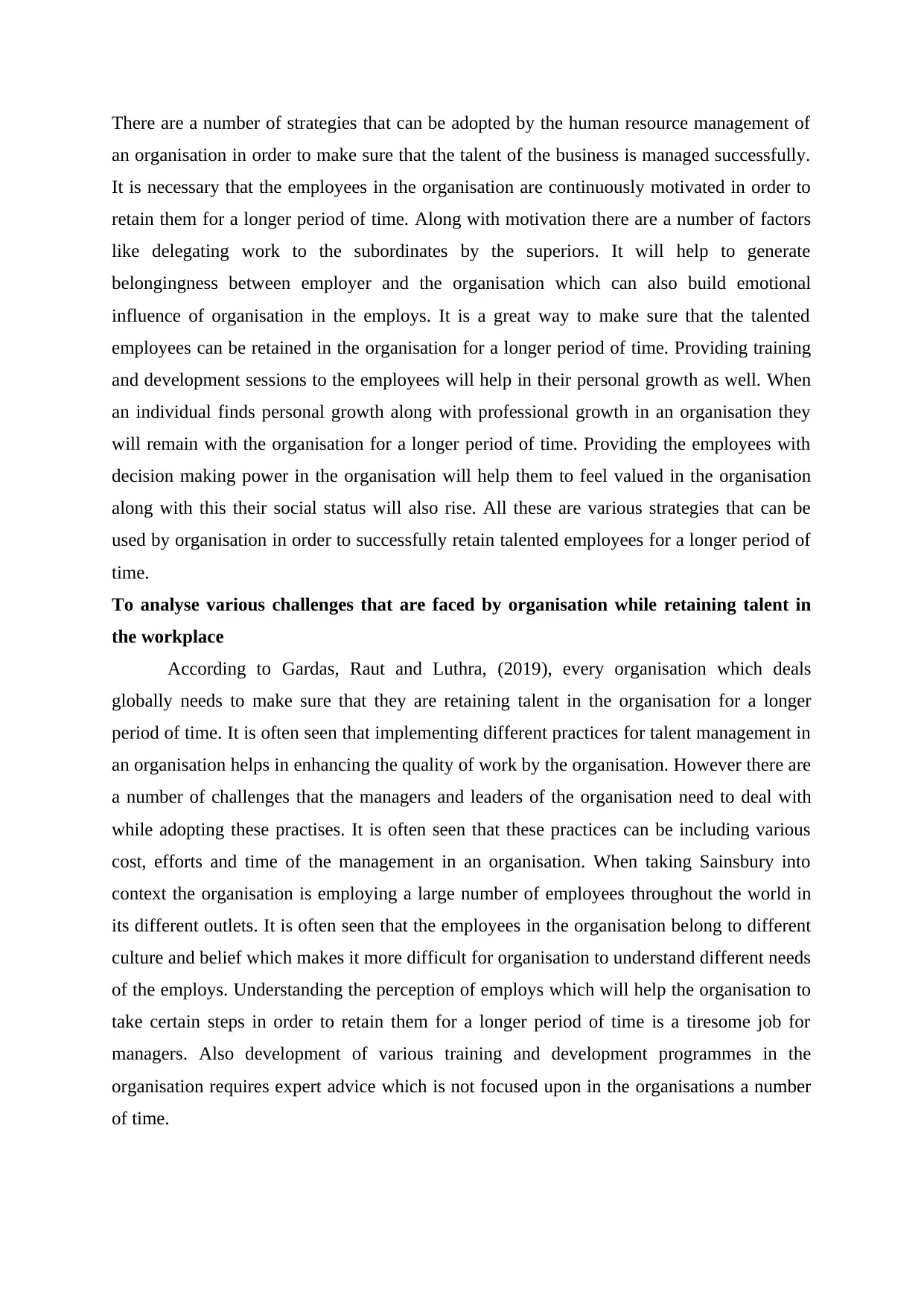
There are a number of strategies that can be adopted by the human resource management of
an organisation in order to make sure that the talent of the business is managed successfully.
It is necessary that the employees in the organisation are continuously motivated in order to
retain them for a longer period of time. Along with motivation there are a number of factors
like delegating work to the subordinates by the superiors. It will help to generate
belongingness between employer and the organisation which can also build emotional
influence of organisation in the employs. It is a great way to make sure that the talented
employees can be retained in the organisation for a longer period of time. Providing training
and development sessions to the employees will help in their personal growth as well. When
an individual finds personal growth along with professional growth in an organisation they
will remain with the organisation for a longer period of time. Providing the employees with
decision making power in the organisation will help them to feel valued in the organisation
along with this their social status will also rise. All these are various strategies that can be
used by organisation in order to successfully retain talented employees for a longer period of
time.
To analyse various challenges that are faced by organisation while retaining talent in
the workplace
According to Gardas, Raut and Luthra, (2019), every organisation which deals
globally needs to make sure that they are retaining talent in the organisation for a longer
period of time. It is often seen that implementing different practices for talent management in
an organisation helps in enhancing the quality of work by the organisation. However there are
a number of challenges that the managers and leaders of the organisation need to deal with
while adopting these practises. It is often seen that these practices can be including various
cost, efforts and time of the management in an organisation. When taking Sainsbury into
context the organisation is employing a large number of employees throughout the world in
its different outlets. It is often seen that the employees in the organisation belong to different
culture and belief which makes it more difficult for organisation to understand different needs
of the employs. Understanding the perception of employs which will help the organisation to
take certain steps in order to retain them for a longer period of time is a tiresome job for
managers. Also development of various training and development programmes in the
organisation requires expert advice which is not focused upon in the organisations a number
of time.
an organisation in order to make sure that the talent of the business is managed successfully.
It is necessary that the employees in the organisation are continuously motivated in order to
retain them for a longer period of time. Along with motivation there are a number of factors
like delegating work to the subordinates by the superiors. It will help to generate
belongingness between employer and the organisation which can also build emotional
influence of organisation in the employs. It is a great way to make sure that the talented
employees can be retained in the organisation for a longer period of time. Providing training
and development sessions to the employees will help in their personal growth as well. When
an individual finds personal growth along with professional growth in an organisation they
will remain with the organisation for a longer period of time. Providing the employees with
decision making power in the organisation will help them to feel valued in the organisation
along with this their social status will also rise. All these are various strategies that can be
used by organisation in order to successfully retain talented employees for a longer period of
time.
To analyse various challenges that are faced by organisation while retaining talent in
the workplace
According to Gardas, Raut and Luthra, (2019), every organisation which deals
globally needs to make sure that they are retaining talent in the organisation for a longer
period of time. It is often seen that implementing different practices for talent management in
an organisation helps in enhancing the quality of work by the organisation. However there are
a number of challenges that the managers and leaders of the organisation need to deal with
while adopting these practises. It is often seen that these practices can be including various
cost, efforts and time of the management in an organisation. When taking Sainsbury into
context the organisation is employing a large number of employees throughout the world in
its different outlets. It is often seen that the employees in the organisation belong to different
culture and belief which makes it more difficult for organisation to understand different needs
of the employs. Understanding the perception of employs which will help the organisation to
take certain steps in order to retain them for a longer period of time is a tiresome job for
managers. Also development of various training and development programmes in the
organisation requires expert advice which is not focused upon in the organisations a number
of time.
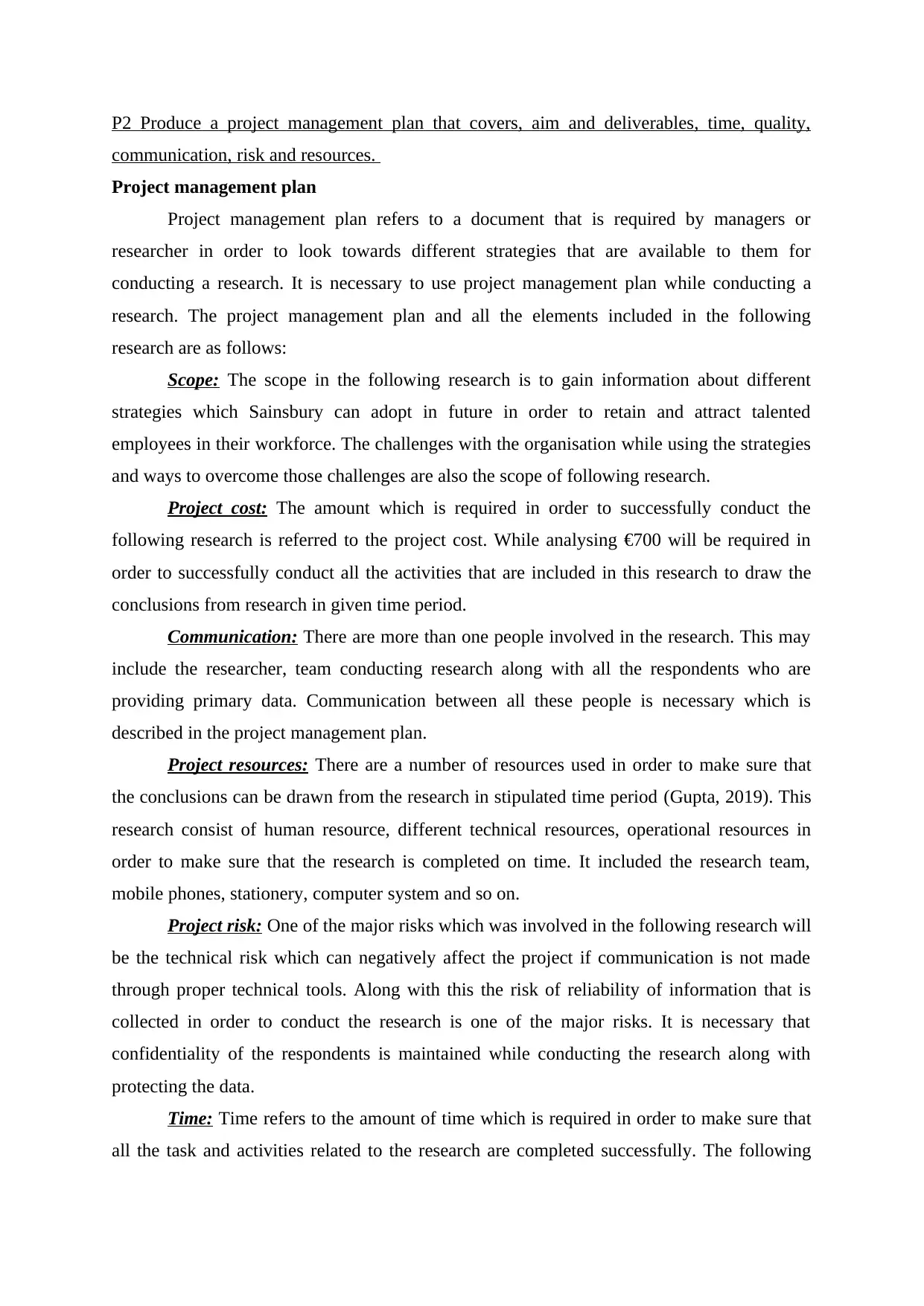
P2 Produce a project management plan that covers, aim and deliverables, time, quality,
communication, risk and resources.
Project management plan
Project management plan refers to a document that is required by managers or
researcher in order to look towards different strategies that are available to them for
conducting a research. It is necessary to use project management plan while conducting a
research. The project management plan and all the elements included in the following
research are as follows:
Scope: The scope in the following research is to gain information about different
strategies which Sainsbury can adopt in future in order to retain and attract talented
employees in their workforce. The challenges with the organisation while using the strategies
and ways to overcome those challenges are also the scope of following research.
Project cost: The amount which is required in order to successfully conduct the
following research is referred to the project cost. While analysing €700 will be required in
order to successfully conduct all the activities that are included in this research to draw the
conclusions from research in given time period.
Communication: There are more than one people involved in the research. This may
include the researcher, team conducting research along with all the respondents who are
providing primary data. Communication between all these people is necessary which is
described in the project management plan.
Project resources: There are a number of resources used in order to make sure that
the conclusions can be drawn from the research in stipulated time period (Gupta, 2019). This
research consist of human resource, different technical resources, operational resources in
order to make sure that the research is completed on time. It included the research team,
mobile phones, stationery, computer system and so on.
Project risk: One of the major risks which was involved in the following research will
be the technical risk which can negatively affect the project if communication is not made
through proper technical tools. Along with this the risk of reliability of information that is
collected in order to conduct the research is one of the major risks. It is necessary that
confidentiality of the respondents is maintained while conducting the research along with
protecting the data.
Time: Time refers to the amount of time which is required in order to make sure that
all the task and activities related to the research are completed successfully. The following
communication, risk and resources.
Project management plan
Project management plan refers to a document that is required by managers or
researcher in order to look towards different strategies that are available to them for
conducting a research. It is necessary to use project management plan while conducting a
research. The project management plan and all the elements included in the following
research are as follows:
Scope: The scope in the following research is to gain information about different
strategies which Sainsbury can adopt in future in order to retain and attract talented
employees in their workforce. The challenges with the organisation while using the strategies
and ways to overcome those challenges are also the scope of following research.
Project cost: The amount which is required in order to successfully conduct the
following research is referred to the project cost. While analysing €700 will be required in
order to successfully conduct all the activities that are included in this research to draw the
conclusions from research in given time period.
Communication: There are more than one people involved in the research. This may
include the researcher, team conducting research along with all the respondents who are
providing primary data. Communication between all these people is necessary which is
described in the project management plan.
Project resources: There are a number of resources used in order to make sure that
the conclusions can be drawn from the research in stipulated time period (Gupta, 2019). This
research consist of human resource, different technical resources, operational resources in
order to make sure that the research is completed on time. It included the research team,
mobile phones, stationery, computer system and so on.
Project risk: One of the major risks which was involved in the following research will
be the technical risk which can negatively affect the project if communication is not made
through proper technical tools. Along with this the risk of reliability of information that is
collected in order to conduct the research is one of the major risks. It is necessary that
confidentiality of the respondents is maintained while conducting the research along with
protecting the data.
Time: Time refers to the amount of time which is required in order to make sure that
all the task and activities related to the research are completed successfully. The following
⊘ This is a preview!⊘
Do you want full access?
Subscribe today to unlock all pages.

Trusted by 1+ million students worldwide
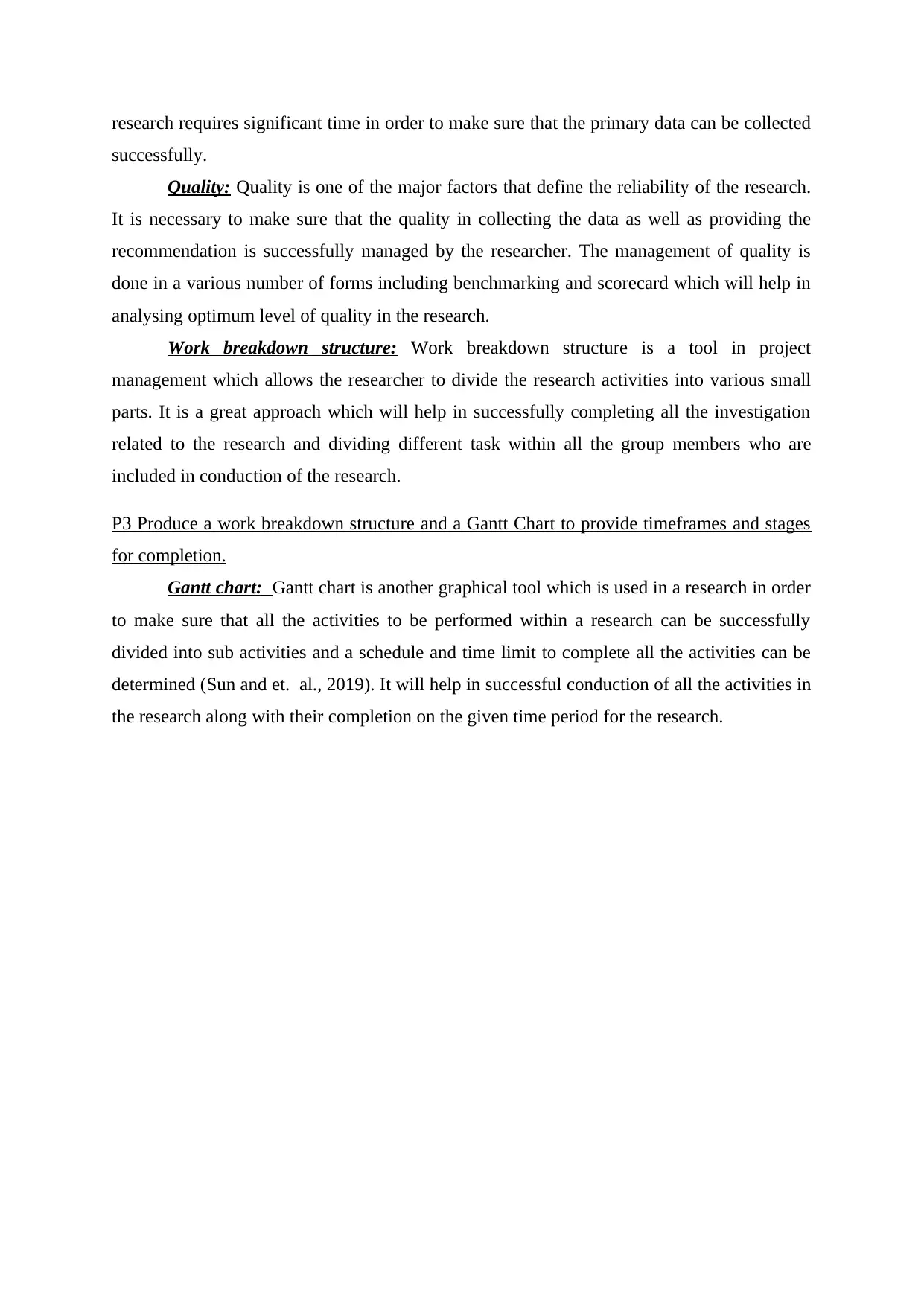
research requires significant time in order to make sure that the primary data can be collected
successfully.
Quality: Quality is one of the major factors that define the reliability of the research.
It is necessary to make sure that the quality in collecting the data as well as providing the
recommendation is successfully managed by the researcher. The management of quality is
done in a various number of forms including benchmarking and scorecard which will help in
analysing optimum level of quality in the research.
Work breakdown structure: Work breakdown structure is a tool in project
management which allows the researcher to divide the research activities into various small
parts. It is a great approach which will help in successfully completing all the investigation
related to the research and dividing different task within all the group members who are
included in conduction of the research.
P3 Produce a work breakdown structure and a Gantt Chart to provide timeframes and stages
for completion.
Gantt chart: Gantt chart is another graphical tool which is used in a research in order
to make sure that all the activities to be performed within a research can be successfully
divided into sub activities and a schedule and time limit to complete all the activities can be
determined (Sun and et. al., 2019). It will help in successful conduction of all the activities in
the research along with their completion on the given time period for the research.
successfully.
Quality: Quality is one of the major factors that define the reliability of the research.
It is necessary to make sure that the quality in collecting the data as well as providing the
recommendation is successfully managed by the researcher. The management of quality is
done in a various number of forms including benchmarking and scorecard which will help in
analysing optimum level of quality in the research.
Work breakdown structure: Work breakdown structure is a tool in project
management which allows the researcher to divide the research activities into various small
parts. It is a great approach which will help in successfully completing all the investigation
related to the research and dividing different task within all the group members who are
included in conduction of the research.
P3 Produce a work breakdown structure and a Gantt Chart to provide timeframes and stages
for completion.
Gantt chart: Gantt chart is another graphical tool which is used in a research in order
to make sure that all the activities to be performed within a research can be successfully
divided into sub activities and a schedule and time limit to complete all the activities can be
determined (Sun and et. al., 2019). It will help in successful conduction of all the activities in
the research along with their completion on the given time period for the research.
Paraphrase This Document
Need a fresh take? Get an instant paraphrase of this document with our AI Paraphraser
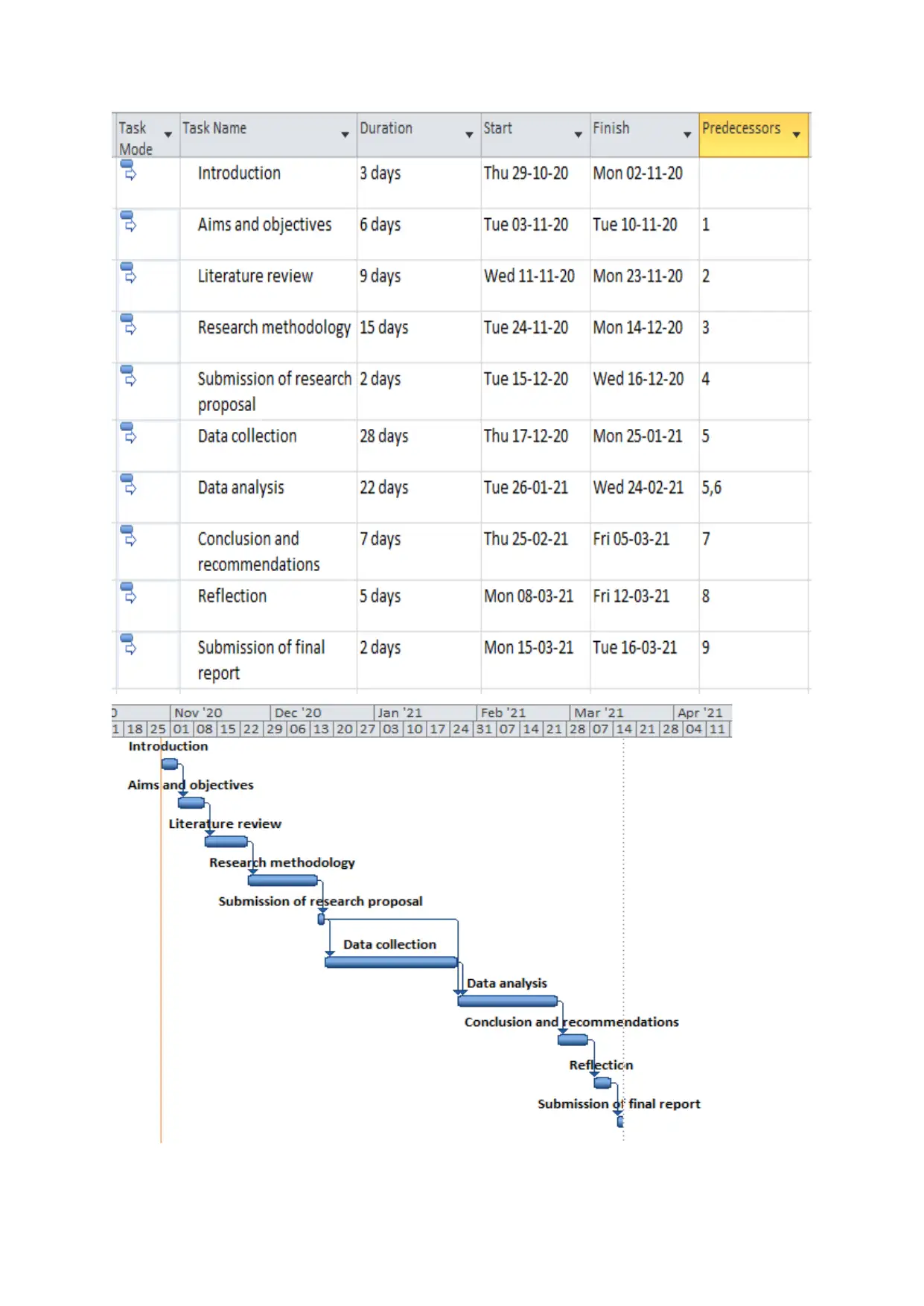
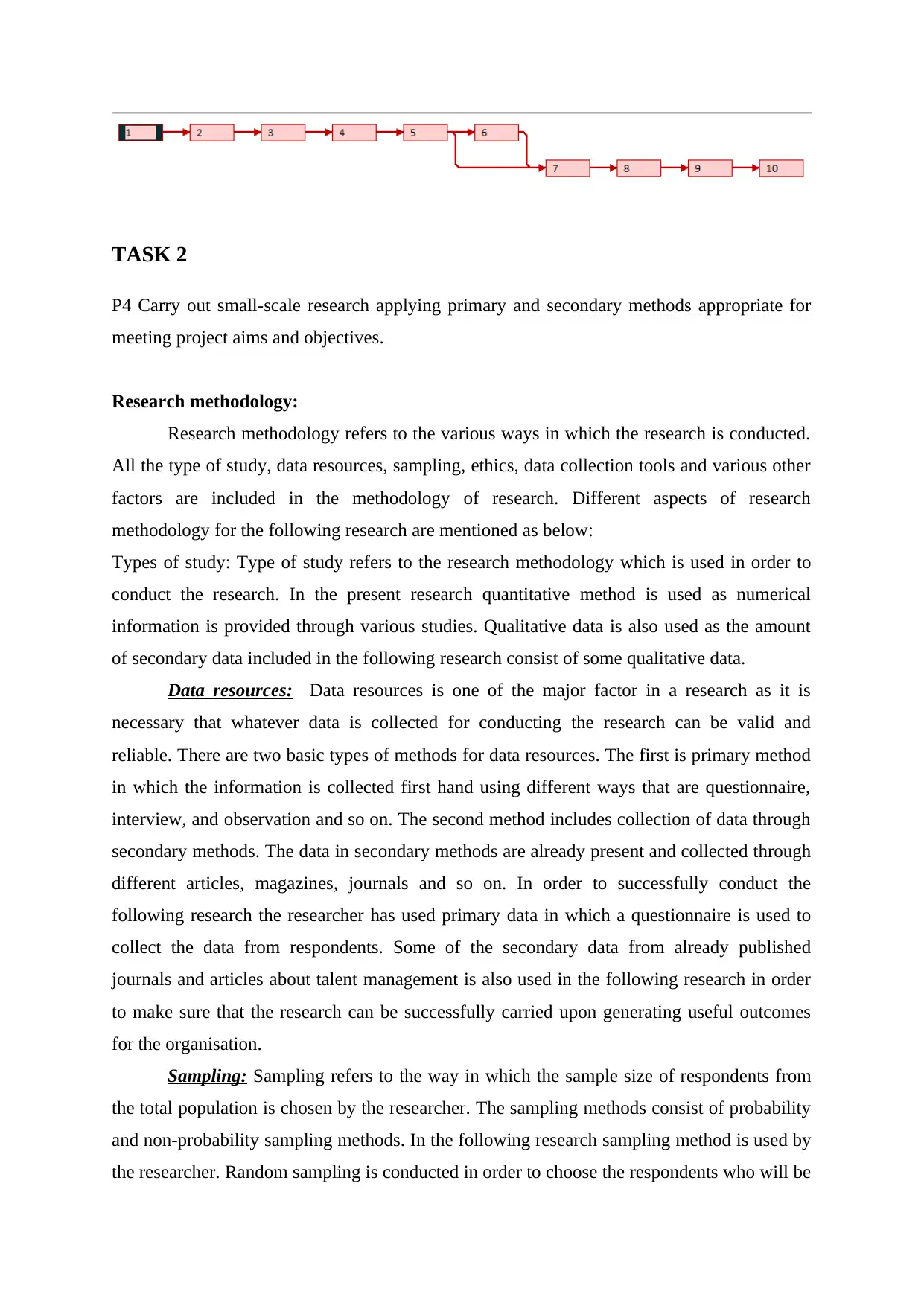
TASK 2
P4 Carry out small-scale research applying primary and secondary methods appropriate for
meeting project aims and objectives.
Research methodology:
Research methodology refers to the various ways in which the research is conducted.
All the type of study, data resources, sampling, ethics, data collection tools and various other
factors are included in the methodology of research. Different aspects of research
methodology for the following research are mentioned as below:
Types of study: Type of study refers to the research methodology which is used in order to
conduct the research. In the present research quantitative method is used as numerical
information is provided through various studies. Qualitative data is also used as the amount
of secondary data included in the following research consist of some qualitative data.
Data resources: Data resources is one of the major factor in a research as it is
necessary that whatever data is collected for conducting the research can be valid and
reliable. There are two basic types of methods for data resources. The first is primary method
in which the information is collected first hand using different ways that are questionnaire,
interview, and observation and so on. The second method includes collection of data through
secondary methods. The data in secondary methods are already present and collected through
different articles, magazines, journals and so on. In order to successfully conduct the
following research the researcher has used primary data in which a questionnaire is used to
collect the data from respondents. Some of the secondary data from already published
journals and articles about talent management is also used in the following research in order
to make sure that the research can be successfully carried upon generating useful outcomes
for the organisation.
Sampling: Sampling refers to the way in which the sample size of respondents from
the total population is chosen by the researcher. The sampling methods consist of probability
and non-probability sampling methods. In the following research sampling method is used by
the researcher. Random sampling is conducted in order to choose the respondents who will be
P4 Carry out small-scale research applying primary and secondary methods appropriate for
meeting project aims and objectives.
Research methodology:
Research methodology refers to the various ways in which the research is conducted.
All the type of study, data resources, sampling, ethics, data collection tools and various other
factors are included in the methodology of research. Different aspects of research
methodology for the following research are mentioned as below:
Types of study: Type of study refers to the research methodology which is used in order to
conduct the research. In the present research quantitative method is used as numerical
information is provided through various studies. Qualitative data is also used as the amount
of secondary data included in the following research consist of some qualitative data.
Data resources: Data resources is one of the major factor in a research as it is
necessary that whatever data is collected for conducting the research can be valid and
reliable. There are two basic types of methods for data resources. The first is primary method
in which the information is collected first hand using different ways that are questionnaire,
interview, and observation and so on. The second method includes collection of data through
secondary methods. The data in secondary methods are already present and collected through
different articles, magazines, journals and so on. In order to successfully conduct the
following research the researcher has used primary data in which a questionnaire is used to
collect the data from respondents. Some of the secondary data from already published
journals and articles about talent management is also used in the following research in order
to make sure that the research can be successfully carried upon generating useful outcomes
for the organisation.
Sampling: Sampling refers to the way in which the sample size of respondents from
the total population is chosen by the researcher. The sampling methods consist of probability
and non-probability sampling methods. In the following research sampling method is used by
the researcher. Random sampling is conducted in order to choose the respondents who will be
⊘ This is a preview!⊘
Do you want full access?
Subscribe today to unlock all pages.

Trusted by 1+ million students worldwide
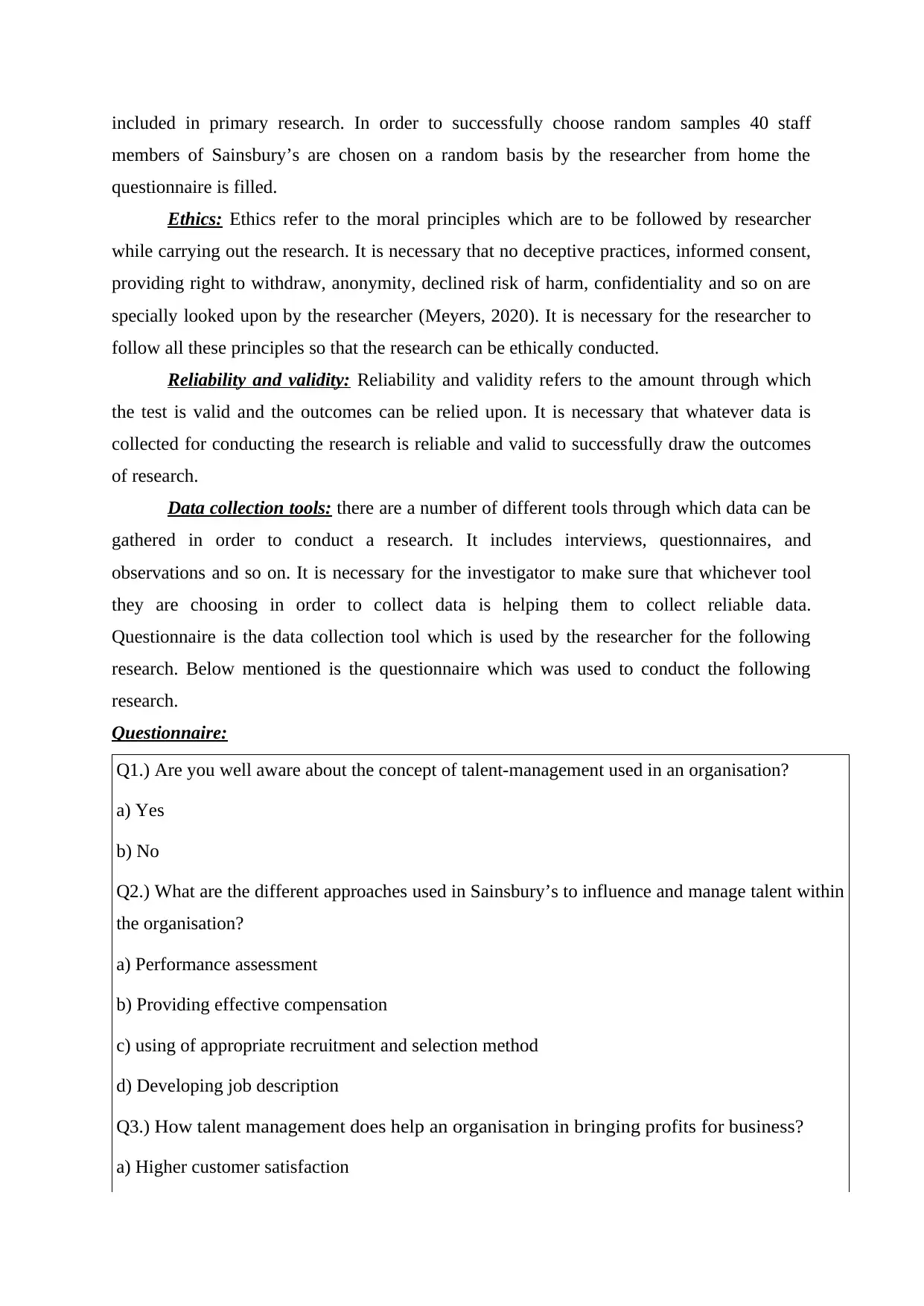
included in primary research. In order to successfully choose random samples 40 staff
members of Sainsbury’s are chosen on a random basis by the researcher from home the
questionnaire is filled.
Ethics: Ethics refer to the moral principles which are to be followed by researcher
while carrying out the research. It is necessary that no deceptive practices, informed consent,
providing right to withdraw, anonymity, declined risk of harm, confidentiality and so on are
specially looked upon by the researcher (Meyers, 2020). It is necessary for the researcher to
follow all these principles so that the research can be ethically conducted.
Reliability and validity: Reliability and validity refers to the amount through which
the test is valid and the outcomes can be relied upon. It is necessary that whatever data is
collected for conducting the research is reliable and valid to successfully draw the outcomes
of research.
Data collection tools: there are a number of different tools through which data can be
gathered in order to conduct a research. It includes interviews, questionnaires, and
observations and so on. It is necessary for the investigator to make sure that whichever tool
they are choosing in order to collect data is helping them to collect reliable data.
Questionnaire is the data collection tool which is used by the researcher for the following
research. Below mentioned is the questionnaire which was used to conduct the following
research.
Questionnaire:
Q1.) Are you well aware about the concept of talent-management used in an organisation?
a) Yes
b) No
Q2.) What are the different approaches used in Sainsbury’s to influence and manage talent within
the organisation?
a) Performance assessment
b) Providing effective compensation
c) using of appropriate recruitment and selection method
d) Developing job description
Q3.) How talent management does help an organisation in bringing profits for business?
a) Higher customer satisfaction
members of Sainsbury’s are chosen on a random basis by the researcher from home the
questionnaire is filled.
Ethics: Ethics refer to the moral principles which are to be followed by researcher
while carrying out the research. It is necessary that no deceptive practices, informed consent,
providing right to withdraw, anonymity, declined risk of harm, confidentiality and so on are
specially looked upon by the researcher (Meyers, 2020). It is necessary for the researcher to
follow all these principles so that the research can be ethically conducted.
Reliability and validity: Reliability and validity refers to the amount through which
the test is valid and the outcomes can be relied upon. It is necessary that whatever data is
collected for conducting the research is reliable and valid to successfully draw the outcomes
of research.
Data collection tools: there are a number of different tools through which data can be
gathered in order to conduct a research. It includes interviews, questionnaires, and
observations and so on. It is necessary for the investigator to make sure that whichever tool
they are choosing in order to collect data is helping them to collect reliable data.
Questionnaire is the data collection tool which is used by the researcher for the following
research. Below mentioned is the questionnaire which was used to conduct the following
research.
Questionnaire:
Q1.) Are you well aware about the concept of talent-management used in an organisation?
a) Yes
b) No
Q2.) What are the different approaches used in Sainsbury’s to influence and manage talent within
the organisation?
a) Performance assessment
b) Providing effective compensation
c) using of appropriate recruitment and selection method
d) Developing job description
Q3.) How talent management does help an organisation in bringing profits for business?
a) Higher customer satisfaction
Paraphrase This Document
Need a fresh take? Get an instant paraphrase of this document with our AI Paraphraser
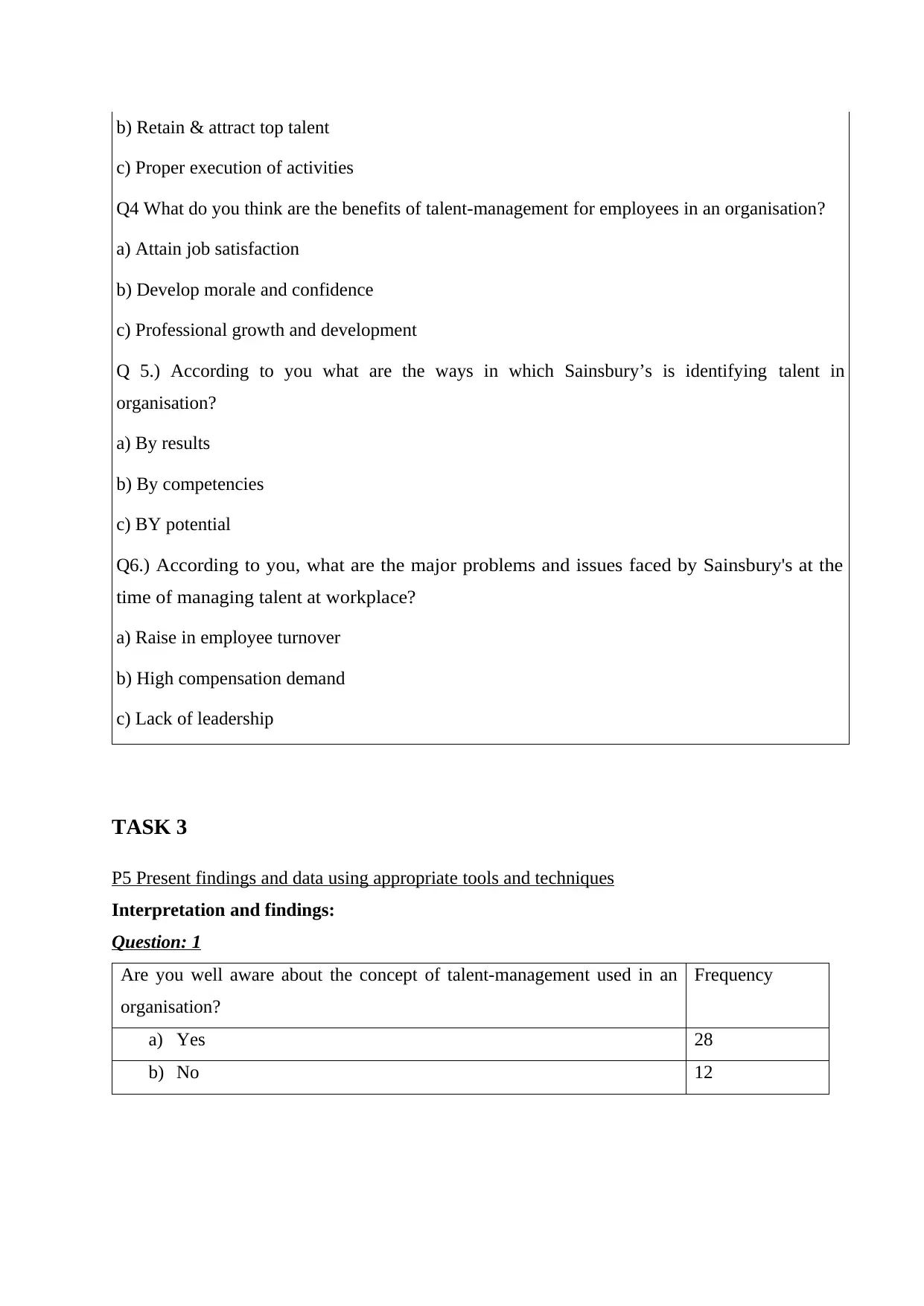
b) Retain & attract top talent
c) Proper execution of activities
Q4 What do you think are the benefits of talent-management for employees in an organisation?
a) Attain job satisfaction
b) Develop morale and confidence
c) Professional growth and development
Q 5.) According to you what are the ways in which Sainsbury’s is identifying talent in
organisation?
a) By results
b) By competencies
c) BY potential
Q6.) According to you, what are the major problems and issues faced by Sainsbury's at the
time of managing talent at workplace?
a) Raise in employee turnover
b) High compensation demand
c) Lack of leadership
TASK 3
P5 Present findings and data using appropriate tools and techniques
Interpretation and findings:
Question: 1
Are you well aware about the concept of talent-management used in an
organisation?
Frequency
a) Yes 28
b) No 12
c) Proper execution of activities
Q4 What do you think are the benefits of talent-management for employees in an organisation?
a) Attain job satisfaction
b) Develop morale and confidence
c) Professional growth and development
Q 5.) According to you what are the ways in which Sainsbury’s is identifying talent in
organisation?
a) By results
b) By competencies
c) BY potential
Q6.) According to you, what are the major problems and issues faced by Sainsbury's at the
time of managing talent at workplace?
a) Raise in employee turnover
b) High compensation demand
c) Lack of leadership
TASK 3
P5 Present findings and data using appropriate tools and techniques
Interpretation and findings:
Question: 1
Are you well aware about the concept of talent-management used in an
organisation?
Frequency
a) Yes 28
b) No 12
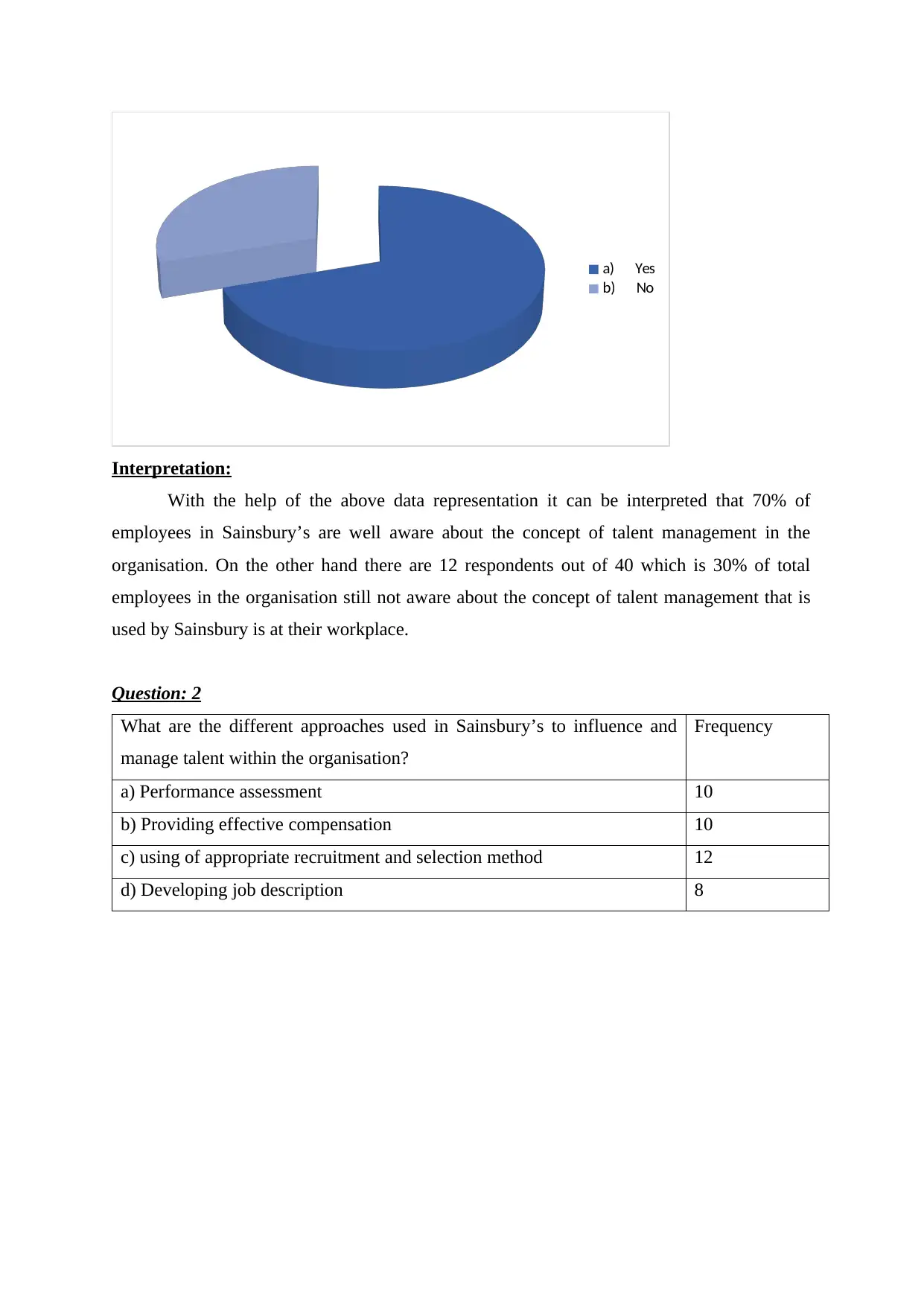
a) Yes
b) No
Interpretation:
With the help of the above data representation it can be interpreted that 70% of
employees in Sainsbury’s are well aware about the concept of talent management in the
organisation. On the other hand there are 12 respondents out of 40 which is 30% of total
employees in the organisation still not aware about the concept of talent management that is
used by Sainsbury is at their workplace.
Question: 2
What are the different approaches used in Sainsbury’s to influence and
manage talent within the organisation?
Frequency
a) Performance assessment 10
b) Providing effective compensation 10
c) using of appropriate recruitment and selection method 12
d) Developing job description 8
b) No
Interpretation:
With the help of the above data representation it can be interpreted that 70% of
employees in Sainsbury’s are well aware about the concept of talent management in the
organisation. On the other hand there are 12 respondents out of 40 which is 30% of total
employees in the organisation still not aware about the concept of talent management that is
used by Sainsbury is at their workplace.
Question: 2
What are the different approaches used in Sainsbury’s to influence and
manage talent within the organisation?
Frequency
a) Performance assessment 10
b) Providing effective compensation 10
c) using of appropriate recruitment and selection method 12
d) Developing job description 8
⊘ This is a preview!⊘
Do you want full access?
Subscribe today to unlock all pages.

Trusted by 1+ million students worldwide
1 out of 19
Related Documents
Your All-in-One AI-Powered Toolkit for Academic Success.
+13062052269
info@desklib.com
Available 24*7 on WhatsApp / Email
![[object Object]](/_next/static/media/star-bottom.7253800d.svg)
Unlock your academic potential
Copyright © 2020–2025 A2Z Services. All Rights Reserved. Developed and managed by ZUCOL.





